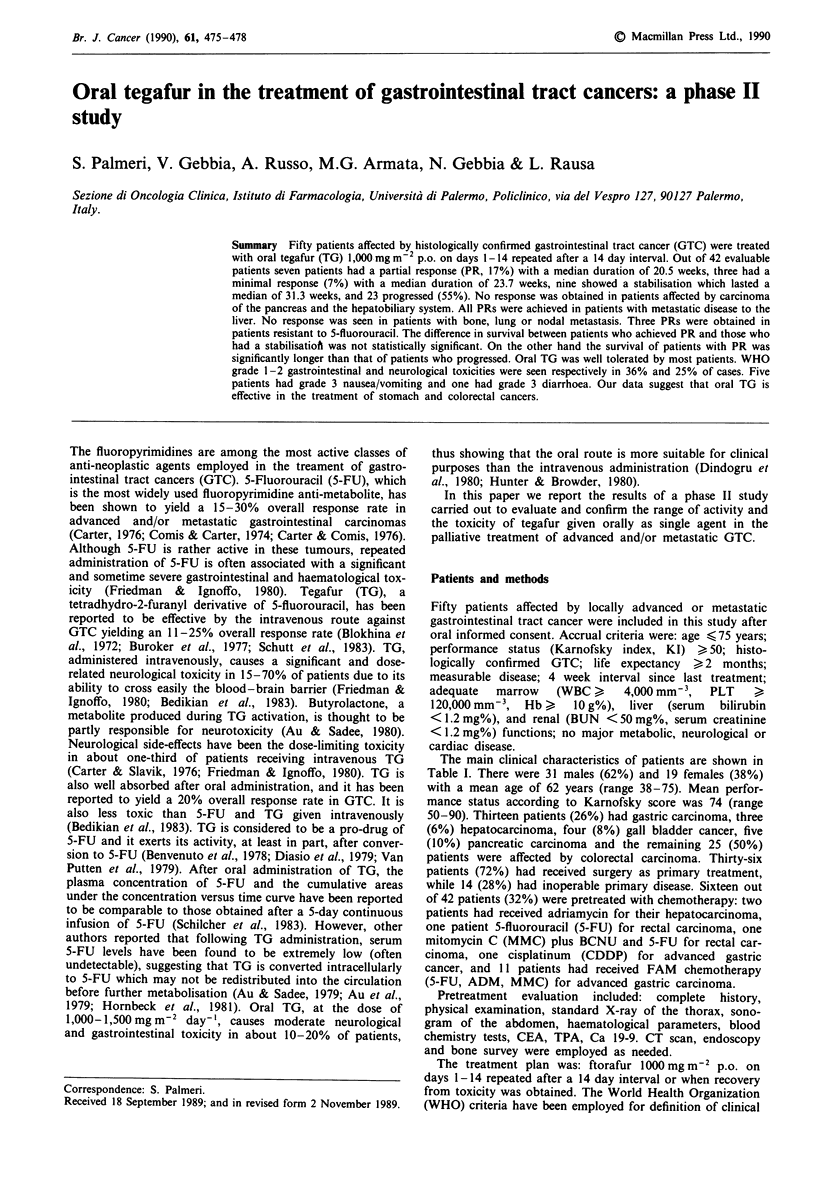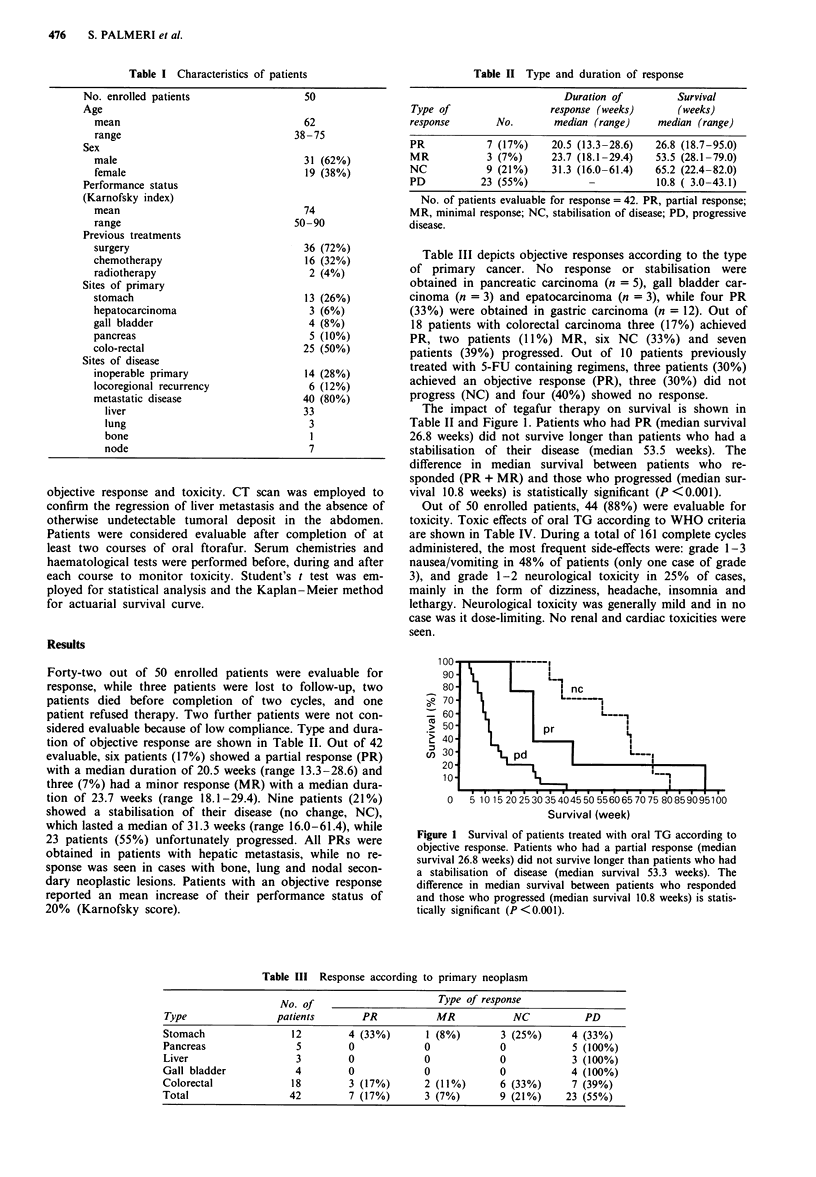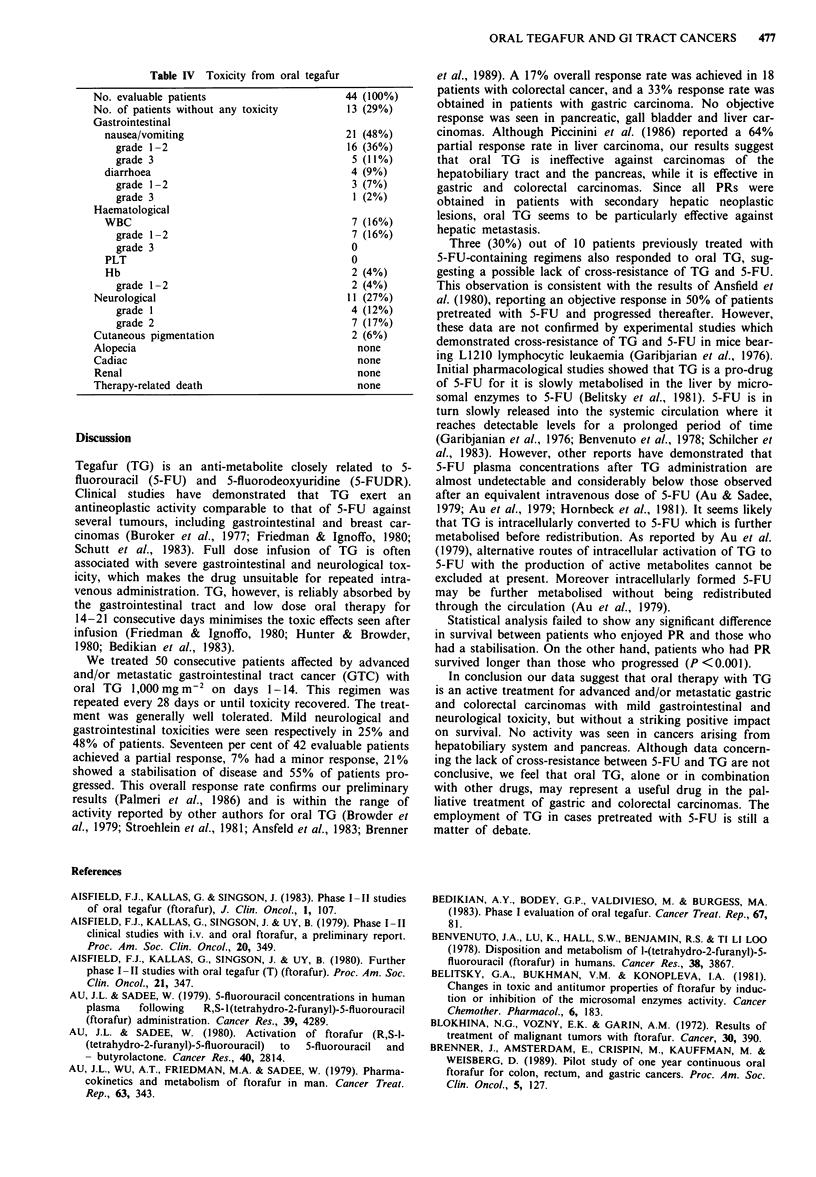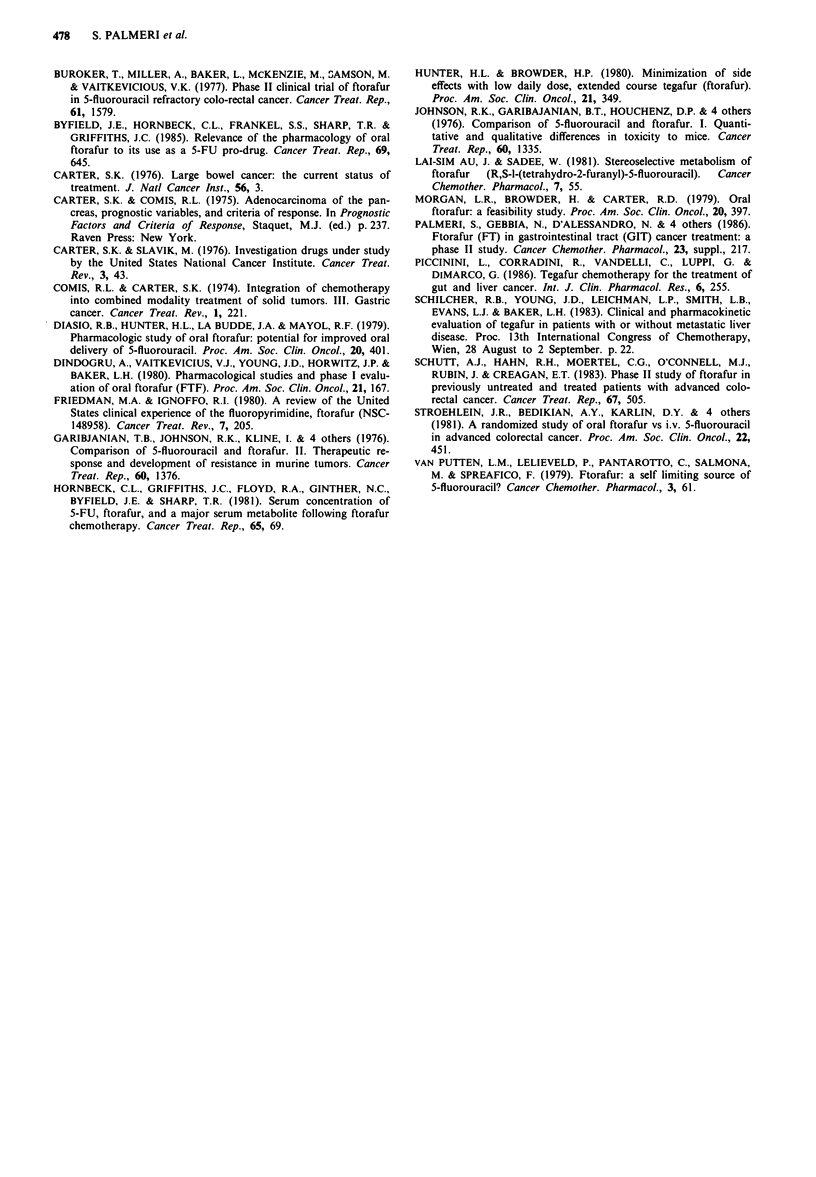Abstract
Fifty patients affected by histologically confirmed gastrointestinal tract cancer (GTC) were treated with oral tegafur (TG) 1,000 mg m-2 p.o. on days 1-14 repeated after a 14 day interval. Out of 42 evaluable patients seven patients had a partial response (PR. 17%) with a median duration of 20.5 weeks, three had a minimal response (7%) with a median duration of 23.7 weeks, nine showed a stabilisation which lasted a median of 31.3 weeks, and 23 progressed (55%). No response was obtained in patients affected by carcinoma of the pancreas and the hepatobiliary system. All PRs were achieved in patients with metastatic disease to the liver. No response was seen in patients with bone, lung or nodal metastasis. Three PRs were obtained in patients resistant to 5-fluorouracil. The difference in survival between patients who achieved PR and those who had a stabilisation was not statistically significant. On the other hand the survival of patients with PR was significantly longer than that of patients who progressed. Oral TG was well tolerated by most patients. WHO grade 1-2 gastrointestinal and neurological toxicities were seen respectively in 36% and 25% of cases. Five patients had grade 3 nausea/vomiting and one had grade 3 diarrhoea. Our data suggest that oral TG is effective in the treatment of stomach and colorectal cancers.
Full text
PDF



Selected References
These references are in PubMed. This may not be the complete list of references from this article.
- Ansfield F. J., Kallas G. J., Singson J. P. Phase I-II studies of oral tegafur (ftorafur). J Clin Oncol. 1983 Feb;1(2):107–110. doi: 10.1200/JCO.1983.1.2.107. [DOI] [PubMed] [Google Scholar]
- Au J. L., Sadée W. 5-Fluorouracil concentrations in human plasma following R,S-1-(tetrahydro-2-furanyl)-5-fluorouracil (ftorafur) administration. Cancer Res. 1979 Oct;39(10):4289–4290. [PubMed] [Google Scholar]
- Au J. L., Sadée W. Activation of Ftorafue [R,S-1-(tetrahydro-2-furanyl)-5-fluorouracil] to 5-fluorouracil and gamma-butyrolactone. Cancer Res. 1980 Aug;40(8 Pt 1):2814–2819. [PubMed] [Google Scholar]
- Au J. L., Wu A. T., Friedman M. A., Sadée W. Pharmacokinetics and metabolism of ftorafur in man. Cancer Treat Rep. 1979 Mar;63(3):343–350. [PubMed] [Google Scholar]
- Belitsky G. A., Bukhman V. M., Konopleva I. A. Changes in toxic and antitumor properties of ftorafur by induction or inhibition of the microsomal enzymes activity. Cancer Chemother Pharmacol. 1981;6(2):183–187. doi: 10.1007/BF00262340. [DOI] [PubMed] [Google Scholar]
- Benvenuto J. A., Lu K., Hall S. W., Benjamin R. S., Loo T. L. Disposition and metabolism of 1-(tetrahydro-2-furanyl)-5-fluorouracil (ftorafur) in humans. Cancer Res. 1978 Nov;38(11 Pt 1):3867–3870. [PubMed] [Google Scholar]
- Blokhina N. G., Vozny E. K., Garin A. M. Results of treatment of malignant tumors with ftorafur. Cancer. 1972 Aug;30(2):390–392. doi: 10.1002/1097-0142(197208)30:2<390::aid-cncr2820300214>3.0.co;2-e. [DOI] [PubMed] [Google Scholar]
- Buroker T., Miller A., Baker L., McKenzie M., Samson M., Vaitkevicius V. K. Phase II clinical trial of ftorafur in 5-fluorouracil-refractory colorectal cancer. Cancer Treat Rep. 1977 Nov;61(8):1579–1580. [PubMed] [Google Scholar]
- Byfield J. E., Hornbeck C. L., Frankel S. S., Sharp T. R., Griffiths J. C. Relevance of the pharmacology of oral tegafur to its use as a 5-FU pro-drug. Cancer Treat Rep. 1985 Jun;69(6):645–652. [PubMed] [Google Scholar]
- Carter S. K. Editorial: Large-bowel cancer-The current status of treatment. J Natl Cancer Inst. 1976 Jan;56(1):3–10. doi: 10.1093/jnci/56.1.3. [DOI] [PubMed] [Google Scholar]
- Carter S. K., Slavik M. Investigational drugs under study by the United States National Cancer Institute. Cancer Treat Rev. 1976 Mar;3(1):43–60. doi: 10.1016/s0305-7372(76)80016-3. [DOI] [PubMed] [Google Scholar]
- Friedman M. A., Ignoffo R. J. A review of the United States clinical experience of the fluoropyrimidine, ftorafur (NSC-148958). Cancer Treat Rev. 1980 Dec;7(4):205–213. doi: 10.1016/s0305-7372(80)80037-5. [DOI] [PubMed] [Google Scholar]
- Hornbeck C. L., Griffiths J. C., Floyd R. A., Ginther N. C., Byfield J. E., Sharp T. R. Serum concentrations of 5-FU, ftorafur, and a major serum metabolite following ftorafur chemotherapy. Cancer Treat Rep. 1981 Jan-Feb;65(1-2):69–72. [PubMed] [Google Scholar]
- Piccinini L., Corradini R., Vandelli C., Luppi G., Di Marco G. Tegafur chemotherapy for the treatment of gut and liver cancer. Int J Clin Pharmacol Res. 1986;6(3):255–260. [PubMed] [Google Scholar]
- Schutt A. J., Hahn R. G., Moertel C. G., O'Connell M. J., Rubin J., Creagan E. T. Phase II study of ftorafur in previously untreated and treated patients with advanced colorectal cancer. Cancer Treat Rep. 1983 May;67(5):505–506. [PubMed] [Google Scholar]
- van Putten L. M., Lelieveld P., Pantarotto C., Salmona M., Spreafico F. Ftorafur: a self-limiting source of 5-fluorouracil? Cancer Chemother Pharmacol. 1979;3(1):61–66. doi: 10.1007/BF00254422. [DOI] [PubMed] [Google Scholar]


